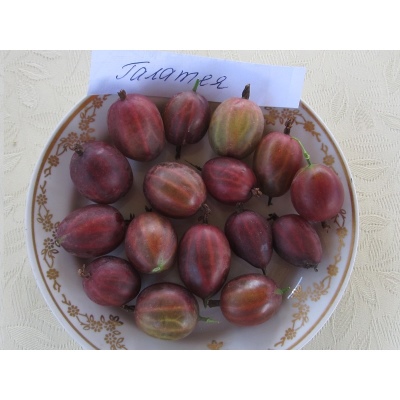
- Authors: E. Yu. Koveshnikova, K. D. Sergeeva
- Growth type: medium-sized
- Description of the bush: medium spreading, powerful
- Escapes: medium thickness, almost straight, light green, with intense anthocyanin coloration
- Thorniness: below average
- Thorns: single, medium length, medium and thin, straight, light, directed perpendicular to the shoot
- Spike location: located along the entire length
- Berry size: large
- Berry weight, g: 6-12
- Berry shape: rounded or oval
The Galatea variety is a fairly young variety. It is considered one of the largest and most productive domestic gooseberry species. Berries are used universally: they are used fresh, for making jam, juice, wine, desserts. The crop is suitable for home garden and industrial cultivation.
Breeding history
The variety was created by breeders E. Yu. Koveshnikova, KD Sergeeva, ND Minaeva, NV Khromov. Obtained by the pollination of Prune and Yubilyar varieties. In 2016, it was transferred for variety trials at the Federal Research Center named after V.I. Michurin.
Description of the variety
The bush is medium-sized, medium-spreading, powerful. Shoots are strong, straight, light green, covered with thin thorns along the entire length. There are more of them in the middle part of the bush, the general spine of the shoots is below average. The leaf is five-lobed, medium-sized, green, matte, slightly wrinkled, slightly convex. The inflorescence is two-flowered.
Flowers and ovaries do not suffer from recurrent frost. The berries are placed very tightly on the branches, in 2-3 rows. The shrub can be propagated by cuttings and layering. Suitable for growing on a trunk.
Characteristics of berries
The berries are large, weighing 6-12 g, oval or round, dark red, the skin is dense, smooth, with a slight waxy bloom, the bones are not large, there are few of them. The fruits are well transported. They look great.
Taste qualities
Dessert taste, sweet and sour, sugary, with a characteristic honey aroma. Tasting score - 4.6-4.8 points.
Ripening and fruiting
The variety is fast-growing: it starts bearing fruit for 2 years, then bears fruit regularly. Medium early in terms of ripening, the harvest sings from mid-July, fruiting is somewhat extended. Berries are not prone to shedding and cracking.
Yield
With high-quality agricultural technology, up to 5 kg are removed from a 6-year-old bush, without leaving it gives about 2 kg.
Growing regions
The culture can be planted throughout Russia, with the exception of the cold northern regions. Suitable for Belarus and Ukraine.
Landing
It is recommended to purchase planting material in a specialized nursery. They prefer 2-year-old bushes with strong intact roots and an aerial part of 2-3 shoots.
Gooseberry prefers fertile clay or sandy soil of neutral acidity. They choose sunny places, sheltered from the north and well-ventilated from the south.
Planted in autumn, September-October, or spring, April-May. The site for planting is dug up on a full bayonet of a shovel, rotted manure is brought in - 0.5 buckets, wood ash - 300 g, nitroammofoska - 1 handful.
The holes are made a little larger than the root volume of the seedling, an interval of 200 cm is left between the seedlings, between the rows - 200 cm.A broken brick is poured at the bottom of the hole, 2 shovels of humus, 100 g of wood ash are poured on top, then a bucket of settled water is poured. The roots are dipped in a clay mash. Seedlings in the hole are placed at an angle. The root collar is deepened by 2-3 cm, the soil is compacted, watered with 1 bucket of water, mulched with peat or humus.
The variety needs regular watering, the soil should not dry out too much. Weeds must be removed, the soil must be loosened.

Growing and care
The shrub loves to grow in moderately moist fertile soil. In dry summers, it is recommended to provide the plant with additional watering. At the end of winter, organic fertilizers are scattered around the bushes - this should be a balanced and slow-release composition. When a brown edge appears on the leaves, potassium dressings are used. The installation of a support is imperative, since during the fruiting period the branches lie on the ground.
The plant slowly grows green mass, so it does not need frequent pruning. Cut off excess shoots growing inside the crown, broken or too weak. Slices are smeared with garden pitch. Pruning is carried out in late winter or early spring.



Disease and pest resistance
The variety has a high immunity to leaf spot, spheroteka, powdery mildew. For preventive treatment, Bordeaux liquid is used 2%, it is sprayed before bud break, and the second time after flowering, but with a 1.5% solution. The branches are covered from birds with a net or non-woven materials.

In order for the gooseberry to produce a good harvest, it is necessary to devote time to disease prevention.
Resistance to adverse climatic conditions
The culture has a very high winter hardiness. It tolerates frosty winters with little snow, including those with frequent thaws and subsequent frosts. Has a high resistance to drought. Adapts to various unfavorable climatic conditions.

Review overview
Galatea is called a fabulously tasty gooseberry variety. In frosty winters, the branches may freeze a little, but in the same year the plant recovers and bears fruit well.



































































